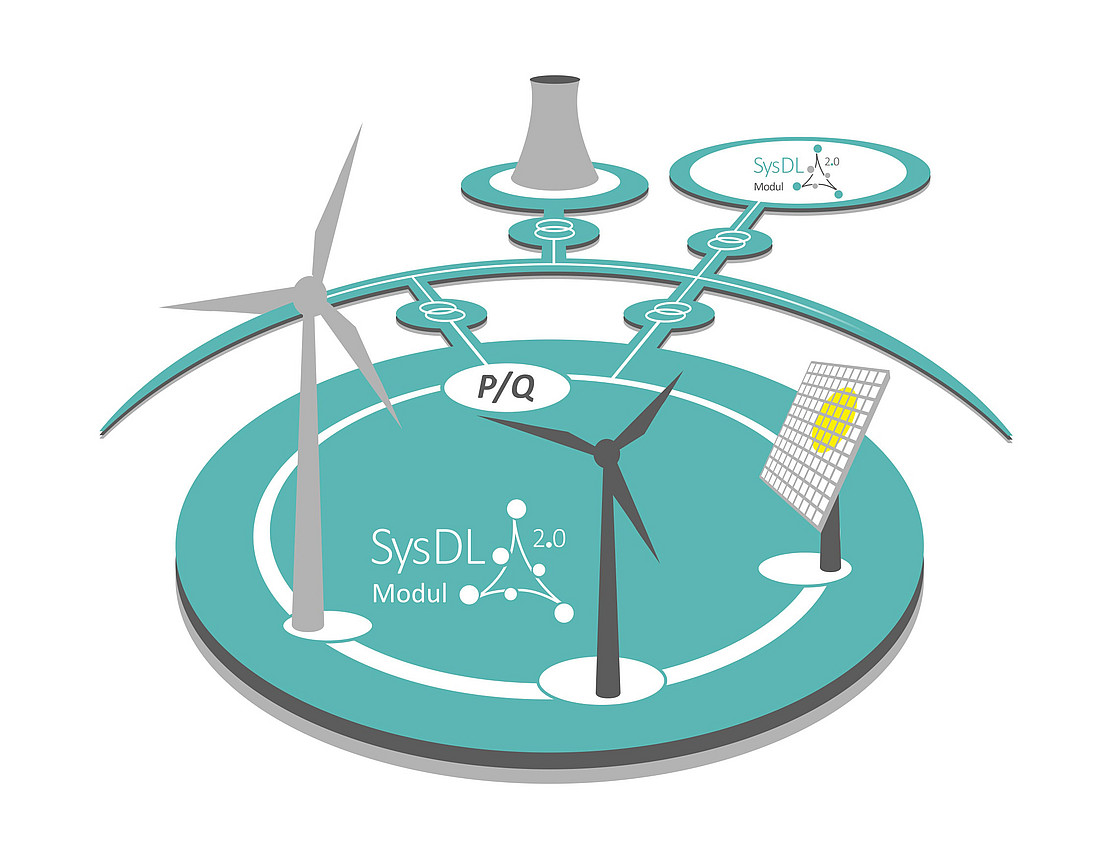This page contains automatically translated content.
Platform for system services from the distribution grids

In addition to control and optimization modules, the platform also includes the necessary components for standardized communication between distribution grid operators and transmission grid operators. In a field test, the research partners finally proved the practical suitability of the platform. The International Smart Grid Action Network (ISGAN) recently honored the project with a bronze medal at the "Award of Excellence 2018".
With the gradual shutdown of conventional power plants, system services for the transmission grid must increasingly come from the distribution grids - where most renewable energy plants feed into the grid."As the energy transition progresses, the small, decentralized renewable energy plants in the distribution grid are increasingly called upon to provide system services for the extra-high voltage grid as well as the high-voltage grid," explains Dr. Sebastian Wende-von Berg, research associate at the Department of Energy Management and Electric Grid Operation at the University of Kassel. "This development requires a coordinated control of generation plants. With "SysDL 2.0", we have developed a platform with which distribution grid operators can meet this task."
In addition to Uni Kassel and Fraunhofer IEE, Drewag Netz GmbH as consortium leader, Mitteldeutsche Netzgesellschaft Strom mbH, 50Hertz Transmission GmbH, F&S Prozessautomation GmbH, Technische Universität Dresden and Siemens AG were directly involved in SysDL 2.0. The project, which was completed in 2018, was funded by the German Federal Ministry for Economic Affairs and Energy as part of the research initiative "Future-proof power grids".
Situation-dependent setpoints for control of generation plants.
In the actual application, the project partners focused specifically on voltage stabilization and optimization of distribution grids through reactive power, in addition to issues such as TSO-VNB communication or the information technology connection of generation plants. "Since the generation structure in the distribution grids is very small-scale and the grids are also closely meshed, energy seeks many different paths to the interconnection points with the transmission grid. These flows must be coordinated. This is the only way to ensure that reactive power is available where it is needed," Wende-von Berg explains. "The fact that this can work was studied in theory in advance at the desk and tested in detail with our OpSim test environment." Jointly developed by Fraunhofer IEE and the University of Kassel, the OpSim test and simulation environment allows users to connect their software to simulated power grids and test it either individually or in combination with other software.
SysDL 2.0 supports voltage maintenance
The SysDL 2.0 platform developed by the project partners provides grid operators with situation-dependent setpoints that they can use to control renewable energy systems in such a way that they support voltage maintenance. The system determines these setpoints based on static and dynamic grid and generation data, which are processed using several modules developed in the research project. These include a solution for task-specific representation of grid topology, a component for describing the state of the grids, forecasting methods for both wind and solar power generation and for vertical load flows between the high- and medium-voltage levels, and an algorithm for coordinating reactive power. A graphical user interface allows grid operators to define use cases and access setpoints for controlling generation assets.
Infrastructure for standardized data exchange
In addition to developing innovative operations management systems, the central tasks of the Kassel-based Fraunhofer researchers within the SysDL 2.0 project group included developing the communications infrastructure. "With the increasing feed-in of electricity from decentralized plants, the previously clearly separated roles of distribution and transmission system operators are mixing. This makes communication between them increasingly important. They must exchange a wide range of information in as standardized a manner as possible - for example, about where, when and how much reactive power is available. Organizing this information flow is one of the core functionalities of SysDL 2.0," explains Wende-von Berg.
The system uses a uniform data model to ensure that the control and optimization modules work with uniform real-time information from the control rooms. The data is transferred via standardized interfaces based on CIM CGMES. Specially developed modules within an Enterprise Service Bus (ESB) coordinate the incoming and outgoing data streams. The combination of a uniform data model and ESB technology creates the necessary flexibility to integrate new functionalities as needed and to further develop the platform for future tasks.
SysDL 2.0: Platform for system services from distribution networks
"With the demonstrator platform for grid operations management newly developed in the SysDL 2.0 project and validated in the field test, we are now in a position to quickly bring new algorithms and operations management approaches, also from third-party research partners, into field test application at grid operators. We are thus accelerating the transfer of results from research to real applications," concludes Prof. Dr. Martin Braun, who heads the Department of Energy Management and Operation of Electrical Networks at the University of Kassel and the Department of Network Planning and Operation at Fraunhofer IEE.
Further information:
sysdl20.de